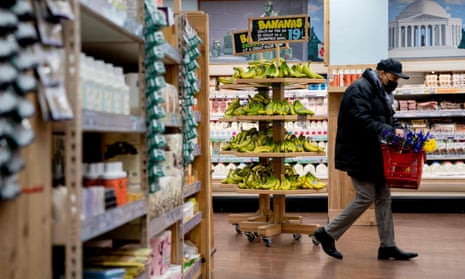Prices in the US climbed at their highest rates since 1981, rising 8.5% over the year to the end of March as the war in Ukraine drove up energy costs for Americans, the labor department announced on Tuesday.
The latest Consumer Price Index (CPI) – which measures the prices of a basket of goods and services – comes after the index rose by 7.9% in the year through February, the fastest pace of annual inflation in 40 years.
Driven up by continuing supply chain problems, soaring demand and rising energy prices, inflation is now at levels unseen in the US since Ronald Reagan took the White House from Jimmy Carter.
The price increases are broad – with the cost of rent, gas and food causing particular hardship for lower income Americans and represent a major blow to the Biden administration, already facing tough odds of retaining control of Congress in November’s midterm elections.
Soaring gas prices were the main driver of the rise. The gasoline index rose 18.3% in March and accounted for over half of all the items’ monthly increase. Gas prices have begun to fall, in a sign that some economists have argued may suggest inflation has reached its peak.
The food index rose 1% in March compared with February, and is up 8.8% compared with the prior 12 months. Canned fruit and vegetable prices rose 3.8% from February to March, rice prices rose 3.2%, potatoes 3.2% and ground beef 2.1%.
Andrew Hunter, senior US economist at Capital Economics, said energy prices would come down in the months ahead and there were signs that price pressures appear to be moderating.
But, he added, the figures were likely to strengthen the Federal Reserve’s plan to increase interest rates as it struggles to tamp down inflation.
“With Fed officials sounding more hawkish by the day, the March data won’t change their plans to up the pace of rate-hikes to 50 basis points per meeting from next month. Even so, it does support our view that, having been slow to realize that the initial surge wasn’t transitory, Fed officials are now being a bit too pessimistic about how quickly inflation will drop back,” he wrote in a note to investors.
The White House warned ahead of the report it was expecting a bad set of figures. On Monday White House press secretary Jen Psaki told reporters that the labor department’s previous report had not included the majority of the jump in oil and gas costs caused by the Kremlin’s invasion of Ukraine.
“We expect March CPI headline inflation to be extraordinarily elevated due to Putin’s price hike,” Psaki said.
There are two versions of the CPI, one that includes all the prices consumers face and another – core CPI – which excludes food and energy prices, which tend to be more volatile. Core prices climbed 6.5% in the year through March, up from 6.4% in the year through February.
The core index did suggest the pace of inflation was slowing, rising 0.3% from February, compared with 0.5% the prior month.
Psaki said the administration expected a wide disparity between the two measures because of the soaring price of gas. Nationally the average price of a gallon of gas is now $4.11, compared with $2.86 a year ago, according to AAA.
“At times, gas prices were more than one dollar above pre-invasion levels, so that roughly 25% increase in gas prices will drive tomorrow’s inflation reading,” Psaki said.
Joe Biden addressed the latest inflation figures at a speech in Des Moines, Iowa, where he announced plans to use more ethanol in US fuel during the summer in an attempt to tackle high gas prices. “I am doing everything in within my executive power to bring down the Putin price hike,” he said.
